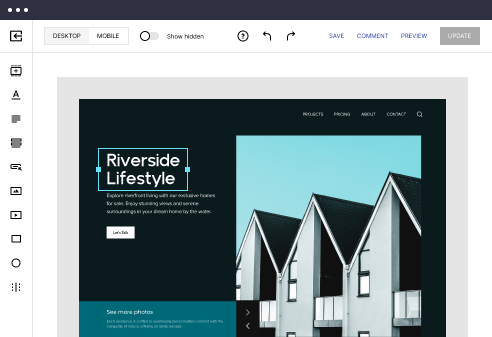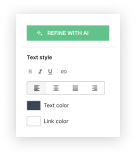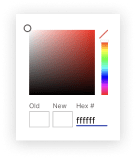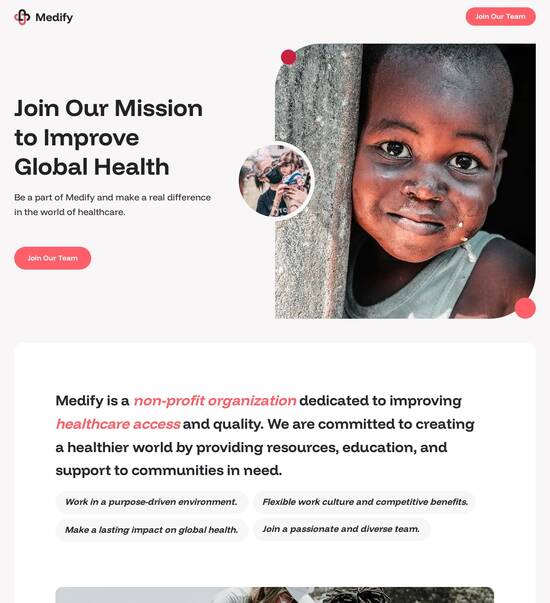
Splash page template for React.js developers
Explore Similar TemplatesAbout template
Master your online marketing with this builder for splash page template for React.js developers. Try more tools to create an immaculate landing page.
Recommended templates
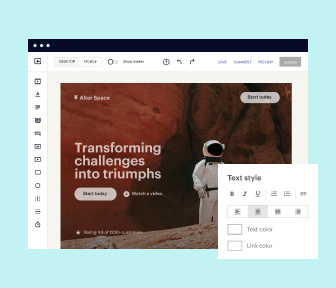
Easy to build without coding
With the intuitive drag-and-drop builder, anyone on your team can create high-converting pages without any knowledge of code or design. Make enhancements to your landing page with custom widgets using Javascript, HTML/CSS, or third-party scripts.
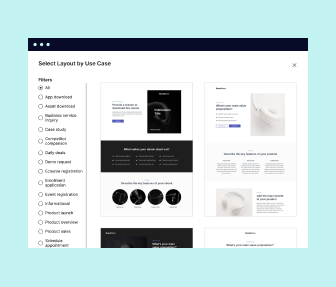
Multiple layouts for any industry and goal
Select from 500+ landing page layouts built to boost conversions across industry-specific scenarios. Customize them by adjusting fonts, adding images, and generating on-brand content with the AI assistant. Quickly scale with Instablocks® and Global Blocks that you can save, reuse, and update globally.
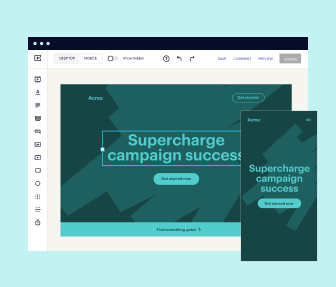
Loads fast and looks polished on any device
Every template is responsive, which means they present professionally on any device and load blazingly fast with our Thor Render Engine. You can also power them up with Google AMP technology to deliver an unparalleled mobile experience and drive higher conversions.
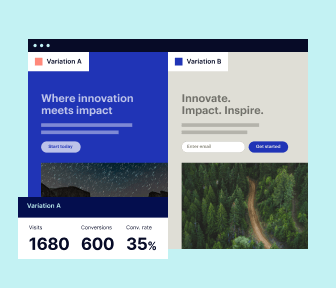
Robust analytics & experimentation
Get real-time updates and reporting across all your devices, showing the number of visitors, conversions, cost-per-visitor, and cost-per-lead. Launch AI-powered experiments, run A/B tests, and use heatmaps to analyze user behavior, then optimize your landing page to maximize conversions.

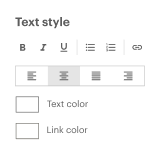
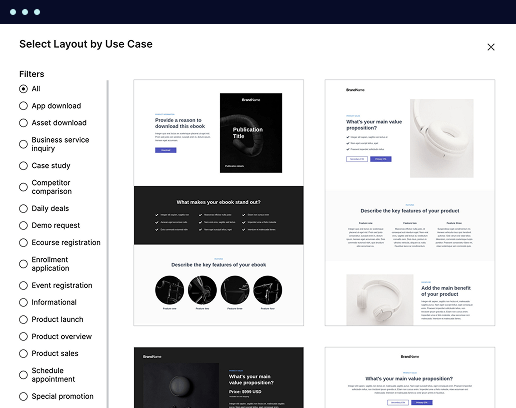
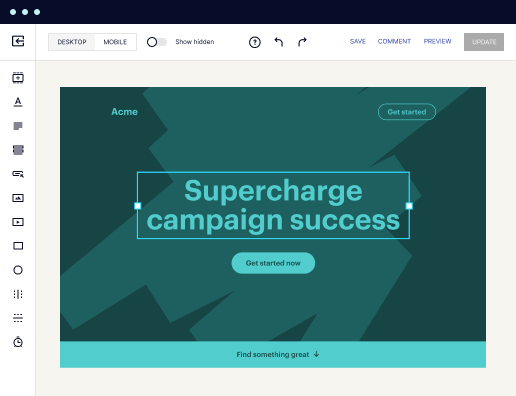
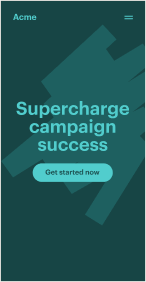
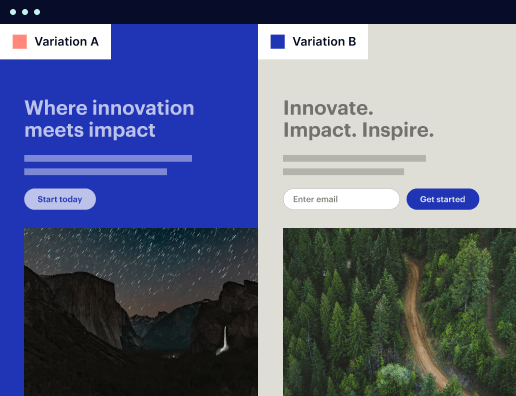

Easy to build without coding
With the intuitive drag-and-drop builder, anyone on your team can create high-converting pages without any knowledge of code or design. Make enhancements to your landing page with custom widgets using Javascript, HTML/CSS, or third-party scripts.
Multiple layouts for any industry and goal
Select from 500+ landing page layouts built to boost conversions across industry-specific scenarios. Customize them by adjusting fonts, adding images, and generating on-brand content with the AI assistant. Quickly scale with Instablocks® and Global Blocks that you can save, reuse, and update globally.
Loads fast and looks polished on any device
Every template is responsive, which means they present professionally on any device and load blazingly fast with our Thor Render Engine.
Robust analytics & experimentation
Get real-time updates and reporting across all your devices, showing the number of visitors, conversions, cost-per-visitor, and cost-per-lead. Launch AI-powered experiments, run A/B tests, and use heatmaps to analyze user behavior, then optimize your landing page to maximize conversions.
All the features you need to build lead-generating landing pages
Explore more featuresLearn how to build top-performing landing pages for any goal
FAQs
Leading the way in building high-performing landing pages





Create Your High-Converting Landing Pages with Instapage
For marketers aiming to maximize ROI through effective campaigns, Instapage stands out as the premier landing page and conversion rate optimization (CRO) platform. This guide will walk you through the key features and benefits of using Instapage, tailored specifically for the needs of businesses in sectors such as marketing, tech, and education across the USA. By leveraging Instapage's powerful capabilities, you can amplify your marketing efforts and improve overall customer engagement.
Understanding the Importance of Landing Pages
Landing pages are critical in guiding prospects towards a specific action, be it signing up for a newsletter, registering for a webinar, or making a purchase. This focused approach significantly increases conversion rates. Instapage provides marketers with the tools to create stunning, conversion-focused landing pages without needing extensive coding skills.
- Accessibility: With a library of 100+ high-converting templates, you can easily customize pages to fit your brand and audience.
- Ease of Use: Instapage’s intuitive drag-and-drop builder allows marketers to create and launch pages swiftly.
- Conversion Optimization: Built-in A/B testing and heatmaps help you optimize page performance based on user engagement and behavior.
Step 1: Choose the Right Template
Selecting an ideal landing page template is crucial for ensuring alignment with your campaign objectives. With Instapage, you can browse through various customizable designs that resonate with your target audience.
Step 2: Customizing Your Page
Once you've chosen your template, the next step is to personalize it. Instapage offers numerous customization options. Consider the following elements:
- Images and Videos: Integrate compelling visuals to make your page more engaging.
- Call-to-Action (CTA): Optimize your CTA buttons to be clear and persuasive.
- Lead Capture Forms: Utilize pre-built lead generation elements to effortlessly collect user information.
Step 3: Optimize for Better Conversions
Optimization goes beyond the aesthetic. With Instapage, you can use various strategies to ensure that your landing page performs optimally. Consider implementing:
- A/B Testing: Test different versions of your landing page to determine which elements drive the most conversions.
- Dynamic Text Replacement: Tailor your messaging in real-time based on visitor data.
- Analytics Tools: Leverage detailed performance metrics to assess your page traffic and user engagement.
By following these steps, you can effectively utilize Instapage to create robust, high-converting landing pages.
Ready to elevate your marketing campaigns? Start your journey with Instapage today and watch your conversion rates soar.
Splash page template for ReactJS developers
Understanding splash pages in ReactJS development
Splash pages serve as the initial interface presented to users navigating an application or website. Their primary function is to provide a welcoming experience, often incorporating visually stimulating designs that capture attention immediately. Unlike landing pages, which focus on driving conversions and specific actions, splash pages are more about setting the mood or branding before the user engages further. They typically appear before any main content is loaded, providing an aesthetically pleasing introduction.
For developers using ReactJS, splash pages can play a vital role in enhancing user experience (UX). They can create a sense of immediacy and anticipation, especially when loading content might take some time. Moreover, a well-designed splash page can effectively communicate branding elements, promote special offers, or deliver messages that set user expectations regarding the experience ahead.
Key components of a React landing page template
Establishing a well-structured React landing page template requires understanding its fundamental components. At its core, a typical splash page template should include a header, main content area, and footer. The header commonly houses the company logo and navigation links, while the main content section engages users with imagery, messaging, or action buttons that are visually appealing. At the bottom, the footer may contain links to additional resources or contact information.
Another crucial aspect when crafting these templates is responsive design. With users accessing websites across a multitude of devices, ensuring that a splash page looks good and functions smoothly on both desktop and mobile devices is imperative. Incorporating CSS frameworks such as Bootstrap or utility-first frameworks like Tailwind CSS can greatly simplify the responsive design process.
Header with logo and navigation links
Main content for engaging visuals and messaging
Footer for additional links and information
Responsive design for mobile and desktop compatibility
Design considerations for effective splash pages
When designing splash pages, visual appeal is paramount. Utilizing color theory can help maintain branding consistency throughout the page. Colors evoke emotions and can influence user perceptions significantly; therefore, choosing a color palette that aligns with brand identity is crucial. Additionally, it’s essential to consider typography—the font choices and their readability significantly affect how users interact with the content.
Customization also plays a key role in creating effective splash pages. By aligning the design with specific business goals, developers can create thematic templates that cater to various audience segments. Gathering user feedback is vital to this process; understanding what resonates with users can guide further iterations and enhancements, ultimately leading to a more effective splash page.
The architecture of a ReactJS splash page template
React's component-based architecture is one of its most significant features, promoting both reusability and maintainability. In a typical splash page, components are broken down into various functional parts; for example, a separate component for the header, one for the main content area, and another for the footer. This modularity makes it easy for developers to modify sections without disrupting the entire layout, which is especially useful when ongoing adjustments based on user behavior or branding changes are necessary.
State management is another essential consideration when structuring a splash page. Managing user interactions and data flow can be effectively handled using React Hooks or the Context API. For more complex applications or when dealing with larger states, many developers rely on Redux. Understanding the pros and cons of each can help developers choose the right approach based on their project's specific needs.
Optimizing user interfaces for SaaS applications
User experience is a critical aspect of any SaaS application. Key features that contribute to improved user engagement include intuitive navigation, aesthetically pleasing designs, and seamless interactions. Tracking metrics such as load speed and bounce rate can provide valuable insights into how well the splash page performs. By assessing these metrics, developers can identify areas for improvement and take necessary actions to enhance user retention.
Personalization techniques also drive engagement. Implementing A/B testing strategies allows developers to experiment with different designs or messaging to see what resonates best with users. Leveraging user data can further enhance personalization efforts, allowing for targeted experiences tailored to specific audiences and ultimately improving conversion rates.
Creating responsive splash pages: a technical guide
A crucial aspect of building modern splash pages is ensuring they are responsive and mobile-friendly. Utilizing CSS frameworks such as Bootstrap or Tailwind CSS can greatly simplify this task. These frameworks offer ready-made classes and components that can significantly speed up the development process while ensuring consistency across devices. Adopting a mobile-first design approach is increasingly essential, given the growing number of users accessing websites via smartphones.
Performance optimization techniques are equally important. Implementing lazy loading for images and components can significantly reduce initial load times, improving user experience. Additionally, code splitting techniques allow developers to break down the application into smaller bundles, loading only what is necessary at any given moment. This approach can enhance performance and make splash pages feel snappier and more welcoming.
Best practices for deploying and maintaining splash pages
Deployment strategies for React applications are varied, with several platforms available for hosting. Prominent options include Vercel and Netlify, both of which provide user-friendly interfaces for deploying React apps quickly and efficiently. Incorporating Continuous Integration/Continuous Deployment (CI/CD) processes ensures that changes and updates can be easily pushed to production without downtime, resulting in a more robust deployment experience.
Monitoring and analytics play a significant role post-deployment. Utilizing tools like Google Analytics or Hotjar can provide insights into user behavior on splash pages, helping developers understand which elements are effective and which may require improvement. Gathering user feedback also grants valuable perspectives on user satisfaction and areas for future enhancements.
Exploring use cases: inspiring examples of effective splash pages
Analyzing successful splash pages, particularly within the SaaS industry, unveils insights into what strategies work best. Companies that effectively engage users often incorporate innovative design elements paired with clear messaging and calls to action. Looking at a few case studies reveals how these splash pages combine branding with functional design to drive user engagement—to capture the interest of users, focus on both aesthetic appeal and informative content.
However, common pitfalls can hinder splash page effectiveness. Frequent mistakes include excessive loading times due to large image files or overly complex designs that may confuse users. Avoiding these challenges requires ongoing iteration based on user feedback, allowing developers to make data-driven decisions to refine and optimize their splash pages continually.
Future trends in splash page development
The landscape of splash page development is continually evolving with the integration of emerging technologies. As artificial intelligence and machine learning become more prevalent in web development, the potential for enhanced user personalization increases significantly. For instance, tailored experiences that adapt in real-time to user behavior can lead to deeper engagement and satisfaction.
Additionally, the possibilities of virtual and augmented reality could revolutionize how users experience splash pages. Designing immersive introductions can captivate users in entirely new ways, setting a higher standard for user interface design. Keeping pace with technological advancements will be essential for developers aiming to create engaging experiences that meet and exceed evolving user expectations.
Engaging tools and resources for ReactJS developers
To reinforce skills in ReactJS development, numerous learning platforms offer valuable courses and tutorials. Websites like freeCodeCamp and Udemy feature comprehensive React programs that can help developers enhance their knowledge base and hands-on skills, ensuring they remain competitive in a rapidly changing field. Community forums like Stack Overflow also serve as excellent resources for troubleshooting and sharing insights, fostering collaborative learning.
Moreover, leveraging design tools like Figma and Sketch can significantly streamline the process of creating mockups for templates. These platforms facilitate collaboration among team members, allowing for instant feedback and adjustments during the design phase. Utilizing version control systems like Git ensures that teams can work together effectively while maintaining project integrity.
Ready to skyrocket conversions?
Supercharge your ad campaigns with high-performing landing pages
Get started